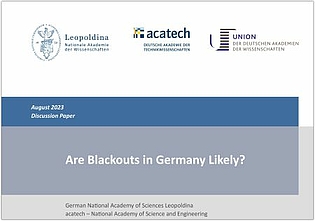News | Friday, 11 August 2023
Blackouts in Germany: Academy project ESYS addresses concerns and looks to the future

In the street, in the media and on political rostrums: there is much discussion about whether the current gas shortage can cause blackouts in Germany. How justified are these concerns? The academies of sciences acatech, Leopoldina and the Union of Academies provide an overview with an impulse paper from their joint project “Energy Systems of the Future” (ESYS): what is the difference between a blackout and other power outages? How are the risks of blackouts shifting as the energy revolution advances? And how can we deal with them?
The impulse paper “Are Blackouts in Germany Likely?” describes the severe extent of a blackout, distinguishes it from other power outages and answers the question in the title in the negative in the context of the current gas crisis. The experts explain how the grid operators would recognize situations in which there is a threat of a shortage and use various measures to maintain control over the grid. In the worst-case scenario, these measures can cause short-term regional interruptions to electricity supplies – especially for a small selection of large industrial consumers. But they are very distinct from a blackout and the drastic consequences currently feared by some.
Digital and decentralized: risks of blackouts are shifting in the course of the energy transition
It is nevertheless important to carefully examine potential risks of a blackout and take preparatory measures – including in the course of the advancing energy transition and increasing digitalization. If it is no longer large power stations but mostly decentralized, scattered wind parks and photovoltaic plants and storage systems that supply our energy, then their management requires the digitalization of the plants and grids. Additionally, the variety of actors in the field of energy is on the rise: charging stations, prosumers and manufacturers of devices that can be controlled via the internet also have an impact on the power grid. In interplay with the expansion of renewable energies, this allows climate-neutral energy supply, but also changes the risks of blackouts.
On the one hand, this reduces risky dependence on energy imports, and digitalization allows faster and better responses to problems. On the other hand, new risks of blackouts arise, for instance due to cyber attacks. Additionally, artificial intelligence will be increasingly used to control plants and equipment. This could lead to undesired behaviour (“negative emergence”). Also, many developments in the field of digitalization and the transformation of the energy system remain uncertain, making it difficult to build a future-proof electric energy system: the technical construction, guidelines, standards and regulations are based on assumptions regarding future developments.
In order to minimize these risks and make the climate-friendly, decentralized and digitalized energy system as supply-secure as possible, we have to act now. To this end, the ESYS experts identify four fields of action:
1. Utilizing decentrality: Increase supply security with targeted use of small generation plants, storage systems and flexible consumers.
2. Security through digitalization: Ensure there are good cyber security standards, including for actors beyond the field of classic electricity supply – for instance prosumers, device manufacturers and platform operators – and increase supply security via digitalization.
3. Involving the public: Communicate risks transparently and on the basis of fact, and negotiate societal rules with respect to how consumers and prosumers should contribute to the resilience of the electricity supply in the future.
4. Institutionalizing resilience strategy with monitoring: Develop and regularly evaluate a national resilience strategy. First of all, it is necessary to agree on parameters in order to quantify resilience.
